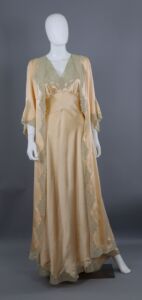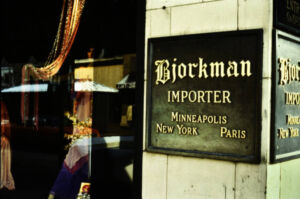By: Nina Clark
4/2/2024

Bjorkman’s dressing gown from the HHM collection.
Hennepin History Museum (HHM) has five objects in its collection that carry the label of Roy H. Bjorkman, a former Minneapolis apparel retailer. These items from his eponymous shop include a white silk gown, a cotton sundress, a blue wool jacket, a wedding gown, a pair of open-toed strappy heels, and the peach loungewear pairing pictured here. As it happens, the donor and wearer of this dramatic silk ensemble is unknown, but we can know a fair bit about where it was purchased. Roy Hampus Bjorkman (1893 to 1984) opened his first dress shop in his hometown of Lincoln, Nebraska in 1923, and then relocated the following year to Minneapolis to open his new store at 931 Nicollet Avenue. The shop quickly cultivated a clientele for ladies’ elegant and upscale dresses, furs, millinery and shoes, and was so successful in its early years that in 1929 the store had 150 people on its payroll, and announced plans to add 4,500 square feet. Bjorkman made several trips each year to Paris and New York to secure the latest designs. His sons took over the business in 1959, and the store remained in business into the 1980s. While Bjorkman’s may be well known to a generation of elite and fashionable shoppers, perhaps less well known is how the name Roy H. Bjorkman intersects with the struggle for labor opportunities for Black residents of Hennepin County.

Image courtesy of Minneapolis Public Library
Bjorkman’s business and his high-class clothing were noticed by Black Twin Citians. The “Minneapolis Society News” column in the May 8, 1936 issue of the Minneapolis Spokesman noted a style show featuring garments from Bjorkman’s. On May 1, “The Debutantes met…at the home of Miss Marjorie Carter, 3729 Fourth Avenue S. Miss Laura Mae Mann was the speaker for the evening, and the club has a private style show,” with Bjorkman items along with “members own clothes.” No other retailer or designer was mentioned. Such fashion shows were popular social occasions for Black women to share in one another’s company, and to celebrate their access to consumer goods, even as access to opportunity more broadly was restricted.
A few years later, Bjorkman received less positive attention in the Spokesman. An article in the October 7, 1949 edition focused on a report of the Minneapolis Joint Committee on Employment Opportunity which found that Roy B. Bjorkman, Inc. was one of just two downtown Minneapolis stores indicating that, “it would ‘be impossible for them to employ Negro people.’” The article’s author responds, “Isn’t that a hot one,” and goes on to say that Bjorkman’s “inexcusable attitude…is in contrast to the true American attitude” of many other Minneapolis retailers, which the author lists. “ The managers and operators of…the Bjorkman Co. are perhaps not aware that 10,000 Minneapolis women, hundreds of them patrons…signed a petition months ago, urging Minneapolis stores to extend full employment opportunity to all nationality and religious groups.”
In her book, Department Stores and the Black Freedom Movement: Workers, Consumers, and Civil Rights from the 1930s to the 1980s, Traci Parker writes about how in the wake of World War II there was an organized movement throughout the United States to advance employment opportunities for Black women in retail settings. For decades, stores had hired Black People, “only as maintenance and stockroom workers, elevator operators, porters and maids- all invisible from the salesroom floor- but barred them from white-collar staff positions in safes, clerical, and management.” In the 1940s, Black-led organizations mobilized to hold retailers to account and demand front-of-shop opportunities. In 1946, the Minneapolis Spokesman had on its cover an article titled, “Gains Made in Department Stores Sales Forces,” naming a report on “Integration of Negroes in Department Stores” and listing hires of Black sales clerks in stores nationwide including in Milwaukee and Chicago. A cover story in the March 26, 1948 issue of the Spokesman proclaims, “Dayton’s Store Employs Two As Sales Clerks,” and also notes, “Schunemans led all the Twin City stores in opening up sales positions to the Negro community.” These news stories signify the degree to which Black Twin Citians were paying close attention to retailers’ actions around hiring practices, and holding them accountable.
What did Roy Bjorkman think about these critiques? Was the person who wore this item of loungewear aware of this debate? It could be tough to surface answers to these questions. But sometimes, viewing an object from a slightly different angle can offer illuminating information and insights, and ultimately new perspectives and avenues for further exploration in a collection.
Author Bio: Nina Clark’s career in cultural organizations has been focused on lifting up underrecognized arts and cultural work through programming and exhibits, community engagement, organizational development, and public media. She has worked at, volunteered for, and consulted for many museums and arts centers, and today serves as Program Officer of Folk Arts & Cultures at the Margaret A. Cargill Philanthropies. Nina also pursues her own creative practices in fiber and sketching, and worked at one time for custom weaver Kelly Marshall. Nina has degrees from Macalester College and the University of Minnesota, and is pursuing an advanced degree in Material Culture and Textile Studies at the University of Nebraska, Lincoln.
Sources:
Advertisement: Minnesota (Roy H. Bjorkman). (1943). Women’s Wear Daily, 67 (129), 1. http://libproxy.unl.edu/login?url=https://www.proquest.com/trade-journals/advertisement-minnesota-roy-h-bjorkman/docview/1653606820/se-2
Bjorkman’s, Minneapolis, In Expansion: Will Add 4,500 Square Feet Of Space—Size Of Debutante Shop To Be Doubled — Is Step In Steady Five-Year Improvement Program. (1929). Women’s Wear Daily, 39(13), 2. http://libproxy.unl.edu/login?url=https://www.proquest.com/trade-journals/bjorkmans-minneapolis-expansion/docview/1654072144/se-2
Humanities, National Endowment for the. “Minneapolis Spokesman. [Volume] (Minneapolis, Minn.) 1934-2000, March 26, 1948, Image 1,” March 26, 1948. https://chroniclingamerica.loc.gov/lccn/sn83025247/1948-03-26/ed-1/seq-1/.
Humanities, National Endowment for the. “Minneapolis Spokesman. [Volume] (Minneapolis, Minn.) 1934-2000, May 08, 1936, Image 5,” May 8, 1936. https://chroniclingamerica.loc.gov/lccn/sn83025247/1936-05-08/ed-1/seq-5/.
Humanities, “Minneapolis Spokesman. [Volume] (Minneapolis, Minn.) 1934-2000, October 07, 1949, Image 3.” https://chroniclingamerica.loc.gov/lccn/sn83025247/1949-10-07/ed-1/seq-3/#date1=01%2F01%2F1949&index=0&date2=12%2F31%2F1949&searchType=advanced&language=&sequence=0&lccn=sn83025247&words=Bjorkman&proxdistance=5&state=Minnesota&rows=20&ortext=bjorkman&proxtext=&phrasetext=&andtext=&dateFilterType=range&page=1
PARKER, T. (2019). Department Stores and the Black Freedom Movement: Workers, Consumers, and Civil Rights from the 1930s to the 1980s. University of North Carolina Press. http://www.jstor.org/stable/10.5149/9781469648699_parker
